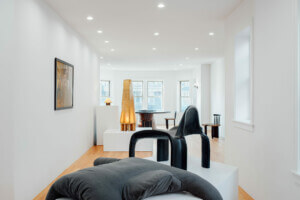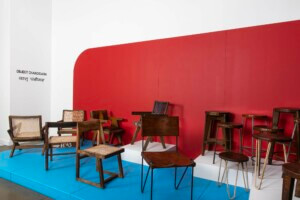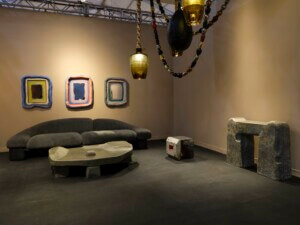Jeffrey Osborne and I were friends for more than three decades. So when I learned that he had died (on March 24th at age 72), the memories came rushing back, but in such a jumble that it’s still hard to untangle them. And there’s a lot to remember.
I first met Jeff around 1979, when I worked at Interiors—my first job at a design magazine. He was then the Vice President of Design at Knoll, and he seemed to know everyone. During the ten years (1976-1986) that he held that job, he worked with a who’s who of contemporary designers and architects, on a series of forward-thinking, high-profile projects: Niels Diffrient’s Diffrient Chair; Joe D’Urso’s classic sectional sofa, table on wheels, and wire-glass coffee table; and furniture by Richard Meier and Robert Venturi, to name a few. Jeff would freely discuss the process of these projects, and had an encyclopedic knowledge of the designers he worked with. His generous sharing of information, insights, and opinions (pro and con) was a big influence on my development as a design journalist, having entered the field armed with just a B.A. in art history and a few months’ experience at the Institute for Architecture and Urban Studies, where I worked on the launch of its monthly newspaper, Skyline.
Jeff was also a generous host and connector of people. You’d see him at WESTWEEK in Los Angeles, NeoCon in Chicago, Designer’s Saturday in New York, or the Milan furniture fair, as well as at the Aspen design conference, where he was executive director for a time after leaving Knoll, and he would organize dinners in all these places, always at the newest or most storied restaurants (of which Jeff kept running lists in his Letts social calendar diaries). One I remember vividly—although not for the actual meal—was at The Musso & Frank Grill in Los Angeles, when Jeff, oblivious to a sign in the parking lot that read, “DO NOT BACK UP: SEVERE TIRE DAMAGE” did just that, and punctured the tires on his expensive rental car. (Completely out of character for Jeff, it provided me with more than one birthday toast.) At these dinners, you’d meet creative people of all types and ages—famous, just starting out, whatever. If Jeff liked you, you were invited along for the ride.
Jeff was also a generous guest; instead of showing up with a bottle of wine or a bunch of flowers, he would appear with a case of wine or an armload of flowers. He was a founding board member—and an enthusiastic supporter—of Publicolor, the New York non-profit established by his friend Ruth Lande Shuman. Whenever we met, Jeff would invariably tell me what his other friends—of whom he was inordinately proud—were up to. A succession of New York apartments overflowed with visitors: someone sleeping on his sofa; a group of people for cocktails or dinner (or both); a mob of friends for his annual Academy Awards party. (Jeff, a meticulous moviegoer and odds-maker, would usually win the Oscar pool.) Entertaining at home was honed to a strict and efficient ritual: the cocktail snacks, for example, consisted of olives, cheese, crackers, and the pistachios that Jeff bought in bulk from Bazzini—and only Bazzini.
Jeff’s aesthetic preferences were clearly defined. He wore custom-made bow ties, and preferred unconstructed (albeit perfectly tailored) jackets and charcoal flannel trousers to suits. But he wasn’t a fashion snob; for several summers, his preferred footwear was a canvas moccasin from Crocs. In addition to the consulting that he did, post-Knoll, for manufacturers (like Unifor) and designers (like Jeffrey Bernett), Jeff designed interiors, which followed a similarly strict set of rules. His paint colors were Benjamin Moore’s Black Iron, a very dark gray, for walls (in semi-gloss), and Collingwood, an off-white, for walls (in eggshell), and ceilings (flat finish). Black Iron is an unexpected but excellent backdrop for art, which Jeff sensibly insisted on hanging low enough that it was easy to see while seated. He thought just as much about how people live in a space as how the space looked, and as far as I can tell, he was never wrong. If you haven’t already guessed, Jeff had informed opinions on everything, and if he thought you were doing or thinking about something the wrong way, he’d say so bluntly—sometimes a little too bluntly. But anyone who knew him knew that Jeff cared as deeply about his friends as he did about design, and his passing is a great loss to both.
A memorial service will be held on April 13th at 4 p.m., at the Frank E. Campbell funeral home, 1076 Madison Avenue. In lieu of flowers, donations may be made to publicolor.org.










